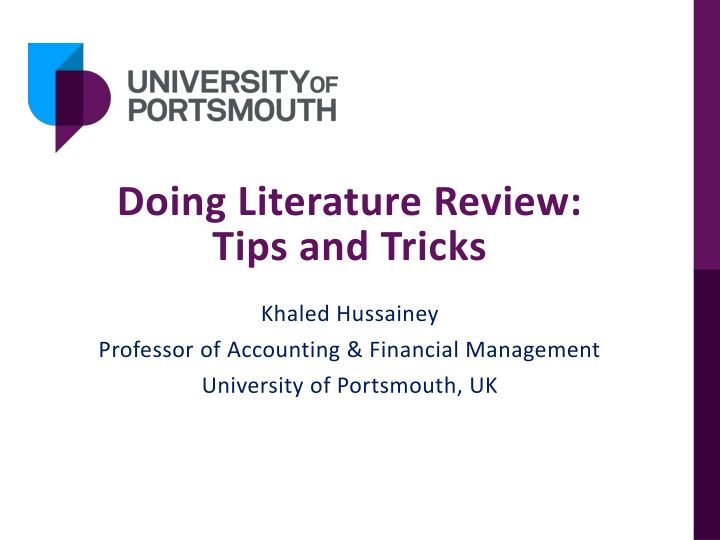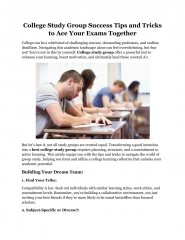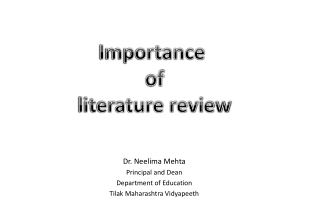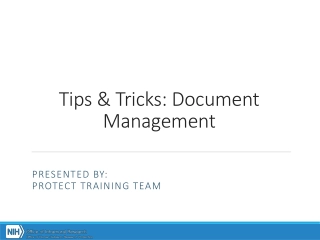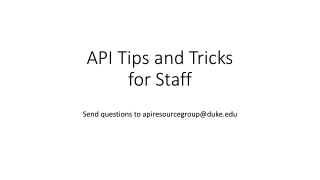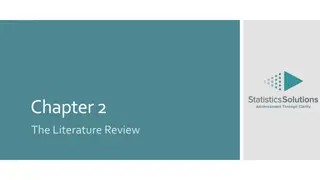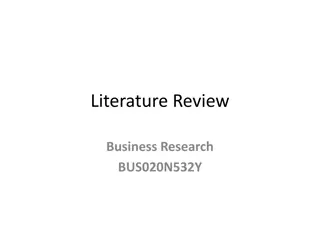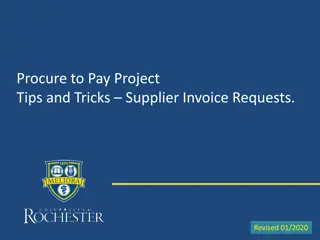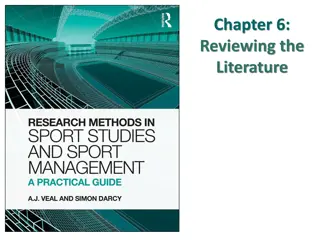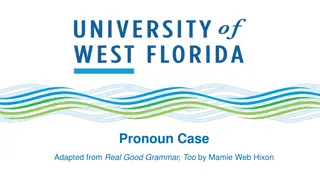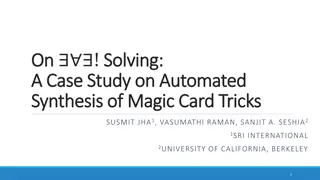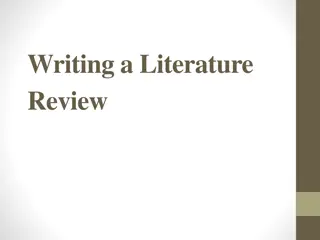Tips and Tricks for Doing a Literature Review Successfully
Explore valuable insights and strategies shared by Khaled Hussainey, a Professor of Accounting & Financial Management, University of Portsmouth, UK. Gain knowledge on structuring literature reviews, identifying research gaps, developing hypotheses, and conducting systematic literature reviews. Discover top-ranked journals, financial accounting journals, major management accounting journals, auditing journals, accounting education journals, public sector accounting, accounting history journals, and major Islamic accounting journals.
Download Presentation

Please find below an Image/Link to download the presentation.
The content on the website is provided AS IS for your information and personal use only. It may not be sold, licensed, or shared on other websites without obtaining consent from the author.If you encounter any issues during the download, it is possible that the publisher has removed the file from their server.
You are allowed to download the files provided on this website for personal or commercial use, subject to the condition that they are used lawfully. All files are the property of their respective owners.
The content on the website is provided AS IS for your information and personal use only. It may not be sold, licensed, or shared on other websites without obtaining consent from the author.
E N D
Presentation Transcript
Doing Literature Review: Tips and Tricks Khaled Hussainey Professor of Accounting & Financial Management University of Portsmouth, UK
Structure Tips for Top-ranked Journals Tips for Literature Review Tips for Research Gaps Tips for Research Contributions Tips for Hypotheses Development Tips for Systematic Literature Review
Major Management Accounting Journals 1. Journal of Cost Management http://maaw.info/JournalofCostManagement.htm 2. Management Accounting Review http://www.journals.elsevier.com/management-accounting-research/ 3. Journal of Management Accounting Research http://aaahq.org/MAS/jmar.cfm 4. Management Accounting Quarterly http://www.imanet.org/resources_and_publications/management_accountin g_quarterly.aspx
Auditing Journals Auditing: A Journal of Practice & Theory The Journal of Accounting, Auditing, and Finance Journal of International Accounting, Auditing and Taxation International Journal of Auditing Managerial Auditing Journal International Journal of Accounting, Auditing and Performance Evaluation
Accounting Education Journals Accounting Education. An International Journal The Journal of Accounting Education Issues in Accounting Education Advances in Accounting Education Accounting Educator s Journal
Public Sector Accounting Governmental Accounting Non-Profit Accounting 8
Major Islamic Accounting Journals Journal of Economic Behavior & Organization (JEBO) http://www.journals.elsevier.com/journal-of-economic-behavior-and- organization/ Accounting, Auditing and Accountability (AAAJ) http://www.emeraldgrouppublishing.com/products/journals/journals .htm?id=AAAJ International Journal of Islamic Financial Services http://www.iiibf.org/journal.html Journal of Islamic Accounting and Business Research http://www.emeraldinsight.com/journals.htm?issn=1759-0817 10 Accounting Forum http://www.sciencedirect.com/science/journal/01559982
Major Islamic Accounting International Journal of Islamic and Middle Eastern Finance and Management http://www.emeraldinsight.com/journals.htm?articleid=1826938 Accounting History http://www.uk.sagepub.com/journals/Journal201764 Journal of Business Ethics http://www.springer.com/social+sciences/applied+ethics/journal /10551 Critical Perspectives On Accounting http://www.journals.elsevier.com/critical-perspectives-on- accounting/
Tips for Literature Review What is a Literature Review? An academic literature review is defined as The selection of available documents (both published and unpublished) on the topic, which contain information, ideas, data and evidence written from a particular standpoint to fulfil certain aims or express certain views on the nature of the topic and how it is to be investigated, and the effective evaluation of these documents in relation to the research being proposed (Hart, 2001, p. 13). Hart, C. (2001). Doing a literature search. London: Sage.
Why do we need a literature review? To identify research gaps. To convince an intended reader that the topic is worth addressing. To highlight the contribution (e.g., which of the research gaps will be filled in the present study). To understand the research background, so we can clarify the research problem, contributions and to avoid replication. To understand relevant concepts and theories. To understand different methodologies used in the literature including data sources. To find out if our findings are consistent with prior research (or not) and (why).
Why citation of literature is important? To give credit to other researchers and acknowledge their ideas. To avoid plagiarism. To enhance credibility of your work. To show off your scientific knowledge.
Critical Literature Review A literature review is an overview of the previously published works on a specific topic. The term can refer to a full scholarly paper or a section of a scholarly work such as a book, or an article. Good critical literature reviews tell a story and help to advance our understanding of what has been done in the literature. A critical review of a journal article evaluates the strengths and weaknesses of an article's ideas and content. It provides critical analysis and interpretation that allow readers to assess the your contribution(s).
Reading critically Think about: What were the research aims of the paper/book? Is the research aim achieved? If so, how did they do it? Are there any problems with their methodology? Was it a strong or a weak research model? How will this research help with your own research? What can you take from it? What needs to be avoided? What are you doing differently?
Critical thinking (a three-year-old s guide) Why? How does that work? What s that made of? What s that for? What does that mean? But X says How do you know? So what? Says who? What happens if
Critical Reading & Analysis When reading critically, focus on the purpose of your literature review: Think about what you expect from the article before reading it Skim the abstract, headings, conclusion, and the first sentence of each paragraph Focus on the arguments presented rather than facts Take notes as you read and start to organise your review around themes and ideas Consider using a table, matrix or concept map to identify how the different sources relate to each other Note four to six points for each study that summarises the main points and conclusions Be as objective as possible Source: https://libguides.murdoch.edu.au/LitReview/read
Analysing your sources Relevance - Is the article relevant to your topic? Is the research methodology comprehensively described? Currency - Is the source up-to-date? Does it consider the latest research on your topic? Reliability - Is the source peer-reviewed? How reputable is the source and what is its impact factor? Provenance - Are the author's arguments supported by evidence (primary material, case studies, narratives, statistics, recent findings)? Persuasiveness - Which of the author's arguments are most/least convincing? Objectivity - What is the purpose of the article and its intended audience? Is contrary data considered or is certain pertinent information ignored to prove the author's point? Can you detect any bias in the content? Accuracy - Does the data support the conclusions drawn? Is the article properly referenced? Value - Are the author's opinions and conclusions convincing? Does the work ultimately contribute in any significant way to an understanding of the subject? Source: https://libguides.murdoch.edu.au/LitReview/read
Note Taking Taking clear, legible notes will help to focus your critical reading and analysis of your literature review sources. When taking notes, avoid plagiarism by: keeping track of the difference between information from your sources and from your own ideas providing clear references, including page numbers Source: https://libguides.murdoch.edu.au/LitReview/read
An important observation The use of literature summary tables is very useful for writing critical review articles We need to: (i) cover most relevant and significant literature related closely to the research questions and objectives (ii) include up-to-date literature
Critical Reading & Analysis Checklist Does your literature review highlight flaws, gaps, or shortcomings of specific texts or groups of texts? Have you identified areas that have not yet been researched or have not yet been researched sufficiently? Does the literature demonstrate a change over time or recent developments that make your research relevant now? Are you able to discuss research methods used to study this topic and/or related topics? Can you clearly state why your research is necessary? Source: https://libguides.murdoch.edu.au/LitReview/read
27 Saunders et al. (2012)
To be critical Criticise the content Criticise the method(s) Criticise the sample Criticise the validity of the analysis Criticise the findings and/or the interpretation of the findings
To be critical use critical-related words A major criticismof Smith s work is that . One question that needs to be asked, however, is whether . A serious weakness with this argument, however, is that . One of the limitations with this explanation is that it does not explain why One criticism of much of the literature on X is that . The key problemwith this explanation is that . The existing accounts fail to resolve the contradiction between X and Y. However, there is an inconsistency with this argument. Smith s argument relies too heavily on qualitative analysis of . It seems that Jones understanding of the X framework is questionable. Smith s interpretation overlooks much of the historical research . X s analysis does not take account of . nor does he examine .
Tips for Research Gaps How do you find research gaps in a research paper? A research gap is defined as a topic or area for which missing or insufficient information limits the ability to reach a conclusion for a question. Research gaps could be found in the conclusion of the article (research limitations and suggestions for future research ). Researchers need to find other research gaps such as: Evidence Gap Empirical Gap Knowledge Gap Practical-Knowledge Gap Methodological Gap Theoretical Gap Population Gap Miles, D. (2017), A Taxonomy of Research Gaps: Identifying and Defining the Seven Research Gaps
Types of Research Gaps*: Evidence Gap: if research findings contradict. Knowledge Gap: There are two settings where a knowledge gap might occur. - First, knowledge may not exist in the actual field to theories and literature from related research domains. - Second, it might be the case that results of a study differs from what was expected. * Miles, D. (2017), A Taxonomy of Research Gaps: Identifying and Defining the Seven Research Gaps
Practical-Knowledge knowledge) conflict arises when the actual behaviour in practice is different from the expected behaviour. In this case, research could seek to determine the scope of the conflict and to uncover the reasons for its existence. Methodological Gap: This gap addresses the conflicts with the research methods in the prior studies and offers a new line of research that is different from those research methods. Empirical Gap: It often addresses conflicts that no study to date has directly attempted to evaluate a subject or topic from an empirical approach. Theoretical Gap: Gaps in theory with the prior research or theoretical conflict. Population Gap: This relates to the population that is not adequately represented or under-researched in the evidence base or prior research. Gap: A practical knowledge (action-
Tips for Research Contributions What is research contribution? How do you find contributions in a research paper? How do you find research gaps in a research paper? What are the types of research contributions? How to think about research contributions with your research? How do you know that you have made a substantial contribution with your research? Where should you write your contribution(s)? How do you write a contribution?
What is research contribution? A ''contribution'' adds to the literature through filling a research gap. A ''contribution shows how your study may offer new insights that previous studies might have missed. Simply what is new in your research? Researchers need to identify from which angle their research is contributing to the literature ?
How do you find contributions in a research paper? In most top-ranked journals, you will find the contribution in the introduction of the paper. Authors use contribution-related keywords such as contribute, contributes, contribution, contributions, new evidence, novel, original, first study, new method, .etc . Consider the contributions of the papers as strengths of the articles when evaluating the literature (e.g. in a critical literature review, you need to evaluate both the strengths and weaknesses of each article).
What are the types of research contributions? - To knowledge: This could be the first article to examine .. - To theory: This research introduces a new theory to the field or it tests if .. theory is applicable to context. - To methodology: The paper aims to introduce a new measure for . To Practice: The paper aims to introduce a practical solution to problem in practice.
How to think about research contributions with your research? You need to evaluate your research: Identify what is new in your research idea, objectives, questions - Identify which research gaps your have filled - Identify the uniqueness of your research context - Identify the novelty of your data, sample period, variables definitions and measurements - Identify the novelty of your research method - Identify the novel findings and insights vis- -vis the existing literature - highlight the research impact (economic, academic/research and policy implications of your findings)
Where do you write a contribution? Choose a title that reflects the contribution of your work. Show the contribution in the abstract. Briefly and clearly discuss the contribution in the introduction. For example, you can say: Consequently, the current paper seeks to make the following contributions to the existing literature. First, , Second, ., Third, , Fourth, and so on . In the literature review section you will need to identify research gaps and highlights the contribution of your work. In the theoretical/conceptual framework you will need to highlight your contributions (if any). In the methodology section you will need to highlight the contributions (if any) related to the context, the sample period, the data, the sample size, the variable definitions and measurement, the method used etc. In the discussion of your findings, you will need to highlight the incremental contributions of your research and its impact.
How do you write a contribution? The (primary) aim of this paper is to contributeto the understanding of This study aims to contribute to this growing area of research by exploring The findings should make an important contribution to the field of It is hoped that this research will contribute to a deeper understanding of Therefore, this study makes a major contribution to research on X by demonstrating There are several important areas where this study makes an original contribution to ... This work contributes to existing knowledge of X by providing ... The findings from this study make several contributions to the current literature. First, These findings contribute in several ways to our understanding of X and provide a basis for Morley (2021)
Tips for Hypotheses Development: By reviewing the literature, you will be able to - Identify research gap - Identify the contribution(s) of the study - clarify the research problem - clarify the research aim/objectives - Clarify the research questions - Understand the concepts and theories related to your topics Ask yourself: 1. Are you familiar with the main concepts related to your research topic? 2. Are you familiar with the main theories related to your topic? 3. Did you understand the conceptual and theoretical framework related to your topic? If yes, you will be able to develop your research hypotheses
- Is your studys conceptual framework logically consistent and credible? - What is the underlying theory that leads to the development of the hypotheses? - Consider potential mediating or moderating variables that would be consistent with your theory - Control variables should also be supported. Mediator variable Independent variables Dependent variable Moderator variable Control variables
Tasmin, R., & Muazu, H. M. (2017). Moderating Effects of Risk Management Function on Determinants of Enterprise Risk Management Implementation in Malaysian Oil and Gas Sector: A Conceptual Framework. Journal of Technology Management and Business, 4(2).
Literature Review as a Research Method Research Methodology and Research Methods Research Methodology Research Methods The concepts and theories which underlines the chosen methods The tools or techniques that we use in our research How the research is done? Whether you are using qualitative or quantitative methods or a mixture of both? And why?
WHAT IS A SYSTEMATIC REVIEW? A systematic review is a type of literature review that uses a systematic method to collect secondary data, critically appraise research studies, and synthesize findings qualitatively or quantitatively. A systematic review starts with a research question that is broad or narrow in scope, and identify and synthesize studies that directly relate to this question. It is designed to provide a summary of current literature, published and unpublished, that is methodical, comprehensive, transparent, and replicable . A systematic review is a review of a clearly formulated question that uses systematic and reproducible method to identify, select and critically appraise all relevant research, and to collect and analyse data from the studies that are included in the review.
Source: https://libguides.brown.edu/Reviews
What is the difference between a systematic review and a meta-analysis? A systematic review is a detailed, systematic and transparent means of gathering, evaluating and synthesising evidence to answer a well-defined question. A meta-analysis is a statistical approach for combining numerical data from multiple separate studies. A meta-analysis should only be conducted in the manner of a systematic review. Source: http://meta-evidence.co.uk/difference-systematic-review-meta-analysis/
Systematic Review Steps Phase 1: Planning a Review Phase 2: Conducting a Review Phase 3: Writing and Reporting the Review - Specify research question - Develop a protocol Search and select studies based on defined criteria - Extract data - Assess quality - Synthese data - The component of the report - Target an appropriate academic journal
Phase 1: Planning a Review Questions - Is this review needed and what is the contribution of conducting this review? - What is the potential audience of this review? - What is the specific purpose and research question(s) this review will be addressing? - What is an appropriate method to use of this review's specific purpose? - What is the search strategy for this specific review? (including search terms, databases, inclusion and exclusion criteria etc.)
